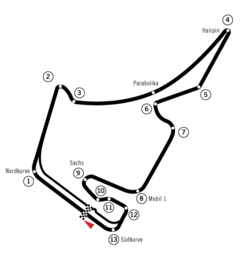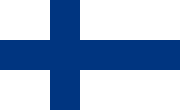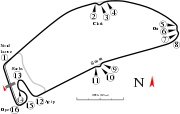Hockenheimring
Hockenheimring
|
 |
| Location |
Hockenheim, Germany |
| Time zone |
GMT +1 |
| Capacity |
120,000 |
| Broke ground |
March 23, 1932 |
| Opened |
May 25, 1932 |
| Major Events |
F1, DTM, German Grand Prix |
| Surface |
Asphalt |
| Circuit Length |
4.574 km (2.842 mi) |
| Turns |
13 |
| Lap Record |
1:13.780 ( Kimi Räikkönen, McLaren, 2004) Kimi Räikkönen, McLaren, 2004) |
The Hockenheimring Baden-Württemberg is an automobile racing track situated near the town of Hockenheim in Baden-Württemberg, Germany. Amongst other motor racing events, it holds the annual Formula One German Grand Prix. Situated in the Rhine valley, the circuit is almost completely flat, with very little change in elevation.
History
1930s - 1960s
Hockenheimring was originally built in 1932 using roads in the forest as an alternative to the Wildpark-Circuit in Karlsruhe, which became forbidden as a racing circuit by German officials. It was used for motorcycle racing and was expanded to be used as test track for Mercedes-Benz and Auto Union in 1936. In 1938 it was renamed the Kurpfalzring and that name was used until 1947. After the war, Grand Prix motorcycle racing events were held, with the German motorcycle Grand Prix alternating between Hockenheim and other tracks.
The original circuit was almost eight kilometres long and consisted of two long straights with a long "Eastern" corner in the forest and a U-turn inside Hockenheim joining them together.
1960s - 2000s

The track prior to 2002
In 1965, when the new Autobahn A 6 separated the village from the main part of the track, a new version of Hockenheim circuit was built, with the "Motodrom" stadium section. After Jim Clark was killed in 1968 in a Formula 2 racing accident, two chicanes and an Armco barrier were added. A small memorial was placed near the first chicane, at the site of his accident. In 1980, another chicane was added at the Ostkurve (east curve), after Patrick Depailler was killed there.
This version used to be quite large, with a very long, fast section going through forests essentially consisting of four straights of roughly 1.3 km, separated by a chicane sequence, followed by a more tight and twisty "stadium" section (so called because of all the grandstands situated there) named Motodrom. This made setting racing cars up difficult, as a choice had to be made - whether to run low downforce to optimise speed through the straights and compromise grip in the stadium section, or vice-versa. The long track length also meant that the spectators only got to see the cars go through the stadium for only 44 laps in a typical Formula 1 race.
2000s
In the early 2000s, F1 officials demanded the 6.8 km (4.2 mi) track be shortened and threatened to discontinue racing there, due to competition from other tracks such as the EuroSpeedway Lausitz and sites in Asia. The state government of Baden-Württemberg secured the financing of the redesign by Hermann Tilke for the 2002 German Grand Prix. The stadium section remained mostly intact, despite a new surface and a tighter Turn 1 ("Nordkurve"). However, the circuit was dramatically shortened, with the long, sweeping forest section chopped off in favour of more tight corners. The old forest section was torn up and replanted with trees. There was a great deal of criticism of the track redesign, but the tight hairpin following the very long back straight offers an overtaking possibility. Lost forever though is the sight of over 20 Formula 1 cars blasting down the long straights to the chicanes on what was a narrow track, along with 70 years of racing history. Many Formula 1 fans are of the opinion that the circuit has lost its soul, and that the old track should have remained, or even that it should br reconstructed, though so far nothing has come of this.
The track has a seating capacity of 120,000, due to new large grandstands sponsored by Mercedes-Benz.
The complex also features a quarter mile track for drag racing. It hosts one of the largest drag racing events in Europe known as the NitroOlympx. The race is one of the few for Top Fuel and Funny Car that runs at 1,320 feet left in 2008 following the shortening of drag races to 1,000 feet (301 m).

Hockenheimring 2004 as viewed from the "Südkurve" of the "Motodrom stadium section", with the main straight visible to the left and dragstrip to the right
Formula 1
The Hockenheim Circuit hosted the German Grand Prix for the first time in 1970 when the F1 drivers decided at the French Grand Prix to boycott the Nürburgring unless major changes were made. The next year the German Grand Prix went back to the Nürburgring until the 1976 German Grand Prix. From 1977 to 2006, the Hockenheimring hosted the German Grand Prix with the exception of 1985, when the race was held at the Nürburgring.
In July 2006, Bernie Ecclestone announced that from 2007 onwards, there would be only one Grand Prix per year in Germany. (Since 1995, there had been two Grands Prix every year in Germany; the German Grand Prix at Hockenheim, plus either the European Grand Prix or the Luxembourg Grand Prix at the Nürburgring.) From 2007 onwards, the Nürburgring and Hockenheimring will alternate hosting the German Grand Prix, starting with the Nürburgring in 2007.
Ongoing deficits of the Formula 1 races, amounting to up to 5.3 million Euro per race that have to be covered by the local communities, have made it likely the contract between the Hockenheimring and the Formula 1 will not be extended after the Grand Prix of 2010.[1].
Deaths from crashes
- 1968 Jim Clark, during a Formula 2 race.
- 1972 Bert Hawthorne, during a Formula 2 race.
- 1980 Patrick Depailler, during a private test session.
References
External links
|
Circuits of the Formula One World Championship |
|
Current circuits
(2008 season) |
|
|
| Future circuits |
New: Yas Marina (2009) · South Jeolla (2010) — Returning: Nürburgring (2009) · Suzuka (2009) · Donington Park (2010)
|
|
| Former circuits |
A1-Ring (Österreichring) · Adelaide · Ain-Diab · Aintree · Anderstorp · AVUS · Brands Hatch · Bremgarten · Buenos Aires · Caesars Palace · Clermont-Ferrand · Dallas · Detroit · Dijon · East London · Estoril · Imola · Indianapolis · Jacarepaguá · Jarama · Jerez · Kyalami · Le Mans · Long Beach · Mexico City · Monsanto · Montjuïc · Mont-Tremblant · Mosport Park · Nivelles-Baulers · Oporto · Paul Ricard · Pedralbes · Pescara · Phoenix · Reims · Riverside · Rouen · Sebring · TI · Watkins Glen · Zandvoort · Zeltweg · Zolder
|
|
|
Deutsche Tourenwagen Masters (DTM) circuits |
|
| Current (2008) |
Brands Hatch · Le Mans · Catalunya · EuroSpeedway · Hockenheimring · Mugello · Oschersleben · Norisring · Nürburgring · Zandvoort
|
|
| Former |
|
|
|
Grand Prix motorcycle racing circuits |
|
| Current circuits (2009) |
Losail · Motegi · Jerez · Le Mans · Mugello · Catalunya · Assen · Laguna Seca · Sachsenring · Donington · Brno · Indianapolis · Misano · Balatonring · Estoril · Phillip Island · Sepang · Valencia |
|
| Past circuits |
Albi · Anderstorp · Buenos Aires · Bremgarten · Charade · Daytona · Dundrod · Eastern Creek · Fuji · Geneva · Goiânia · Hedemora · Hockenheim · Hungaroring · Imatra · Imola · Interlagos · Isle of Man · Istanbul · Jarama · Johor · Karlskoga · Kristianstad · Kyalami · Magny-Cours · Montjuïc · Monza · Mosport · Nogaro · Nürburgring · Opatija · Paul Ricard · Suzuka · Reims · Grobnik · Rio de Janeiro · Rouen · Salzburgring · San Carlos · Schottenring · Sentul · Shanghai · Shah Alam · Silverstone · Solitude · Spa-Francorchamps · Tampere · Welkom · Zeltweg |
|
|
Superbike World Championship circuits |
|
| Current circuits (2009) |
Phillip Island · Losail · Valencia · Assen · Monza · Kyalami · Salt Lake City · Misano · Donington Park · Brno · Nürburgring · Vallelunga · Magny-Cours · Portimao
|
|
| Past circuits |
Albacete · Anderstorp · Brainerd · Brands Hatch · Estoril · EuroSpeedway Lausitz · Hockenheim · Hungaroring · Imola · Johor · Jarama · Jerez · Laguna Seca · Le Mans · Manfeild · Mosport · Mugello · Oran Park · Oschersleben · Österreichring · Paul Ricard · Pergusa · Salzburgring · Sentul · Shah Alam · Silverstone · Spa-Francorchamps · Sugo · Zeltweg
|
|
|
F3 Euroseries 2008 |
|
| Drivers |
Hülkenberg • Jakes • Bianchi • Lancaster • Vietoris • Janiš • Mäki • Bird • Breen • Tsukakoshi • Oshima • Mortara • Mailleux • Vernay • Coletti • Wickens • van der Zande • Kimball • Clos • Klein • Dillmann • Campos-Hull • Shaaban • Götz • Plowman • Klingmann • Cheng • Waldschmidt • Clairay • Ricciardo • Philippe • González • Hartley • Richelmi • Elkmann • Panciatici • Vervisch • Oakes
|
|
| Teams |
ART Grand Prix • Mücke Motorsport • Manor Motorsport • Signature-Plus • Prema Powerteam • Jo Zeller Racing • HBR Motorsport • RC Motorsport • SG Formula • Carlin Motorsport • Barazi Epsilon
|
|
| Circuits |
|
|


